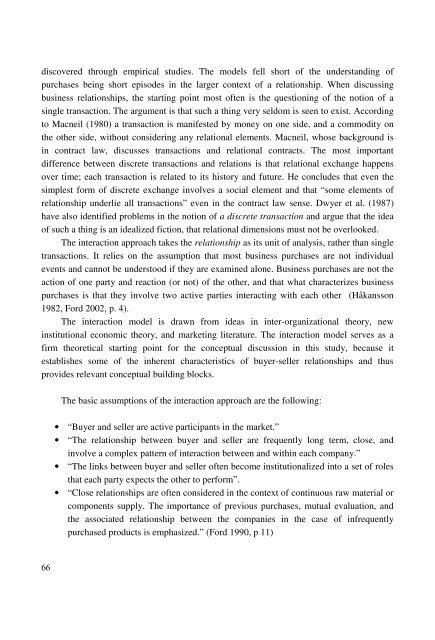Value Co-Creation in Industrial Buyer-Seller Partnerships ... - Doria
Value Co-Creation in Industrial Buyer-Seller Partnerships ... - Doria
Value Co-Creation in Industrial Buyer-Seller Partnerships ... - Doria
- No tags were found...
Create successful ePaper yourself
Turn your PDF publications into a flip-book with our unique Google optimized e-Paper software.
discovered through empirical studies. The models fell short of the understand<strong>in</strong>g ofpurchases be<strong>in</strong>g short episodes <strong>in</strong> the larger context of a relationship. When discuss<strong>in</strong>gbus<strong>in</strong>ess relationships, the start<strong>in</strong>g po<strong>in</strong>t most often is the question<strong>in</strong>g of the notion of as<strong>in</strong>gle transaction. The argument is that such a th<strong>in</strong>g very seldom is seen to exist. Accord<strong>in</strong>gto Macneil (1980) a transaction is manifested by money on one side, and a commodity onthe other side, without consider<strong>in</strong>g any relational elements. Macneil, whose background is<strong>in</strong> contract law, discusses transactions and relational contracts. The most importantdifference between discrete transactions and relations is that relational exchange happensover time; each transaction is related to its history and future. He concludes that even thesimplest form of discrete exchange <strong>in</strong>volves a social element and that “ some elements ofrelationship underlie all transactions” even <strong>in</strong> the contract law sense. Dwyer et al. (1987)have also identified problems <strong>in</strong> the notion of a discrete transaction and argue that the ideaof such a th<strong>in</strong>g is an idealized fiction, that relational dimensions must not be overlooked.The <strong>in</strong>teraction approach takes the relationship as its unit of analysis, rather than s<strong>in</strong>gletransactions. It relies on the assumption that most bus<strong>in</strong>ess purchases are not <strong>in</strong>dividualevents and cannot be understood if they are exam<strong>in</strong>ed alone. Bus<strong>in</strong>ess purchases are not theaction of one party and reaction (or not) of the other, and that what characterizes bus<strong>in</strong>esspurchases is that they <strong>in</strong>volve two active parties <strong>in</strong>teract<strong>in</strong>g with each other (Håkansson1982, Ford 2002, p. 4).The <strong>in</strong>teraction model is drawn from ideas <strong>in</strong> <strong>in</strong>ter-organizational theory, new<strong>in</strong>stitutional economic theory, and market<strong>in</strong>g literature. The <strong>in</strong>teraction model serves as afirm theoretical start<strong>in</strong>g po<strong>in</strong>t for the conceptual discussion <strong>in</strong> this study, because itestablishes some of the <strong>in</strong>herent characteristics of buyer-seller relationships and thusprovides relevant conceptual build<strong>in</strong>g blocks.The basic assumptions of the <strong>in</strong>teraction approach are the follow<strong>in</strong>g:• “ <strong>Buyer</strong> and seller are active participants <strong>in</strong> the market.”• “ The relationship between buyer and seller are frequently long term, close, and<strong>in</strong>volve a complex pattern of <strong>in</strong>teraction between and with<strong>in</strong> each company.”• “ The l<strong>in</strong>ks between buyer and seller often become <strong>in</strong>stitutionalized <strong>in</strong>to a set of rolesthat each party expects the other to perform” .• “ Close relationships are often considered <strong>in</strong> the context of cont<strong>in</strong>uous raw material orcomponents supply. The importance of previous purchases, mutual evaluation, andthe associated relationship between the companies <strong>in</strong> the case of <strong>in</strong>frequentlypurchased products is emphasized.” (Ford 1990, p 11)66
















